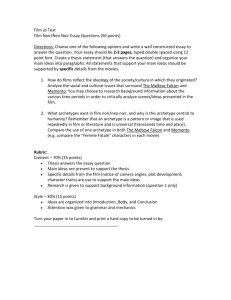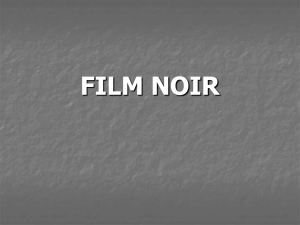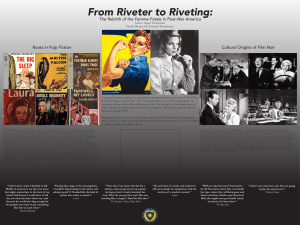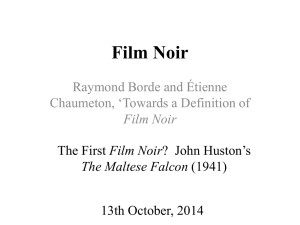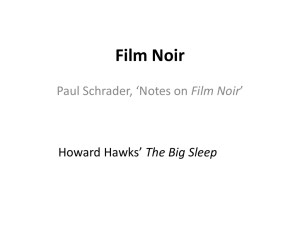film noir
advertisement
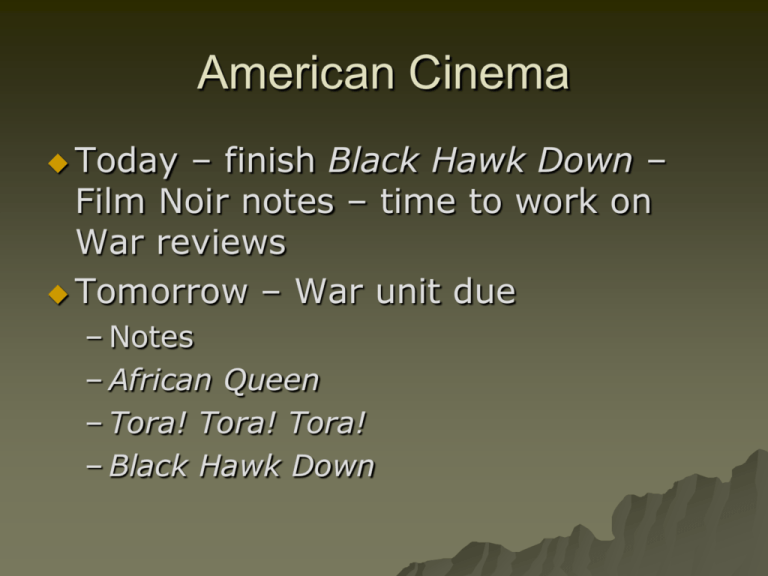
American Cinema Today – finish Black Hawk Down – Film Noir notes – time to work on War reviews Tomorrow – War unit due – Notes – African Queen – Tora! Tora! Tora! – Black Hawk Down Film Noir “Black Film” Or “Dark Film” The film noir genre was born Some film from crime films: noir films audiences grew bored with have the criminal protagonist criminals and wanted more of a hero private eyes, during war times but not all more intelligent: German private eye Expressionists heavily influenced by mise-en-scene or crime films are film noir. Lasted from 1945-ish to 1950-ish There is no true definition of a film noir, yet many contain similar characteristics Darkness represents two ideas: Darkness of setting Darkness of humanity Humphrey Bogart in The Maltese Falcon (1941) Darkness of the Setting Cities: Mean, nasty places where anything can happen at any moment Violence and crime occur often, usually randomly Sex: strip clubs, bars, sultry women abound Cities are grimy, dirty places with lots of shadows. Darkness of the Setting Fog: Fog obscures, makes unclear and unknown. Fate, mystery, future . Casablanca (1942) What Lies Beneath (2000) Water: What lies under the water? Rarely can the audience see below the surface of water Sometimes choppy and tumultuous Film Lighting noir uses high contrast lighting with lots of shadows. Sometimes props are the only source of light This is called low key lighting. – Little key lighting (principle source of light) – Mostly fill light (lights from side or back) – Comedies, musicals use high key lighting to create uniform light with little contrast What do you see for lighting in this image of Bogart from Casablanca (1942)? Notice the Brox Sisters in 1929’s Singing in the Rain. What do you notice about the lighting? Darkness of Humanity: It’s a world of paranoia and entrapment Male protagonist feels trapped and overwhelmed by a situation Chance plays a larger role than fate Heavy use of mise-en-scene to show craziness and entrapment: – – – – – Bars or lines in front or behind character Tight framing Odd angles Slow tracking shots Backward tracking shots Femme Fatale A “dangerous woman” who traps or pulls the male protagonist (usually a common, everyday Joe) into a world of crime and danger She is sexy, dangerous, often filled with “mad love,” greed, or jealousy Often, one or the other, maybe both, will die. AKA – The Spider Woman – Ensnares the hero in a web of danger, lies and death Other Symbols Fog, water, cities, shadows – All show obscurity or the unknown mystery Transportation: – Used as a weapon or a place of isolation and escape – Cars, trains, planes, boats Double Indemnity (1944) Other Symbols Clothing: – Symbol of status, power, innocence or guilt The Lady from Shanghai (1947) Mirrors and glass: – Sharp and dangerous yet fragile, like life – Shows all people are the same – Something might be hidden behind a mirror Postmodern Film Noir Even though film noir died out, it still exists: – Small details have been taken from the classics (symbols, lighting, characters) – Some feel film noir must be black and white, others feel that high contrast can be achieved through vivid colors Examples: Blade Runner (1982), The Usual Suspects (1995), Glengarry Glen Ross (1992) The Maltese Falcon 1941 John Huston A private detective takes on a case that involves him with three eccentric criminals, a gorgeous liar, and their quest for a priceless statuette. Double Indemnity 1944 Billy Wilder An insurance rep lets himself be talked into a murder/insurance fraud scheme that arouses an insurance investigator's suspicions. Double indemnity - a provision in a lifeinsurance or accident policy whereby the company agrees to pay twice the face of the contract in case of accidental death
